 |
Types and Materials of Industrial Insulation |
Any surface which is hotter than its surroundings will lose heat. The heat loss depends on many factors, but the surface temperature and its size are dominant.
Putting the insulation on a hot surface will reduce the external surface temperature. By insulation, the surface will increase on objects, but the relative effect of temperature reduction will be much greater and heat loss will be reduced.
A similar situation occurs when the surface temperature is lower than its surroundings. In both cases some energy is lost. These energy losses can be reduced by laying the practical and economical insulation on surfaces whose temperatures are quite different than the surrounding one.
Categories of Insulation Materials
Insulation materials or systems may also be categorized by service temperature range.
There are varying opinions as to the classification of mechanical insulation by the service temperature range for which insulation is used. As an example, the word cryogenics means "the production of freezing cold"; however the term is used widely as a synonym for many low temperature applications. It is not well-defined at what point on the temperature scale refrigeration ends and cryogenics begins.
The National Institute of Standards and Technology in Boulder, Colorado considers the field of cryogenics as those involving temperatures below -180°C. They based their determination on the understanding that the normal boiling points of the so-called permanent gases, such as helium, hydrogen, nitrogen, oxygen and normal air, lie below -180°C while the Freon refrigerants, hydrogen sulfide and other common refrigerants have boiling points above -180°C.
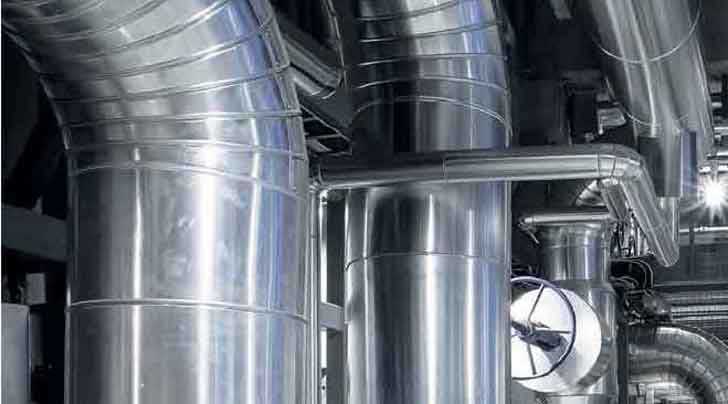
Understanding that some may have a different range of service temperature by which to classify mechanical insulation, the mechanical insulation industry has generally adopted the following category definitions..
| Category | Definition |
| Cryogenic Applications | -50°F and Below |
| Thermal Applications.. | |
| Refrigeration, chill water and below ambient applications | -49°F to +75°F |
| Medium to high temp. applications | +76°F to +1200°F |
| Refractory Applications | +1200°F and Above |
Cellular insulations are composed of small individual cells either interconnecting or sealed from each other to form a cellular structure. Glass, plastics, and rubber may comprise the base material and a variety of foaming agents are used.
Cellular insulations are often further classified as either open cell (i.e. cells are interconnecting) or closed cell (cells sealed from each other). Generally, materials that have greater than 90% closed cell content are considered to be closed cell materials.
Fibrous insulations are composed of small diameter fibers that finely divide the air space. The fibers may be organic or inorganic and they are normally (but not always) held together by a binder. Typical inorganic fibers include glass, rock wool, slag wool, and alumina silica.
Fibrous insulations are further classified as either wool or textile-based insulations. Textile-based insulations are composed of woven and non-woven fibers and yarns. The fibers and yarns may be organic or inorganic. These materials are sometimes supplied with coatings or as composites for specific properties, e.g. weather and chemical resistance, reflectivity, etc.
Flake insulations are composed of small particles or flakes which finely divide the air space. These flakes may or may not be bonded together. Vermiculite, or expanded mica, is flake insulation.
Granular insulations are composed of small nodules that contain voids or hollow spaces. These materials are sometimes considered open cell materials since gases can be transferred between the individual spaces. Calcium silicate and molded perlite insulations are considered granular insulation.
Reflective Insulations & treatments are added to surfaces to lower the long-wave emittance thereby reducing the radiant heat transfer to or from the surface. Some reflective insulation systems consist of multiple parallel thin sheets or foil spaced to minimize convective heat transfer. Low emittance jackets and facings are often used in combination with other insulation materials.
Cellular Insulations
Elastomeric
Elastomeric insulations are defined by ASTM C 534, Type I (preformed tubes) and Type II (sheets). There are three grades in the ASTM standard which are widely available.
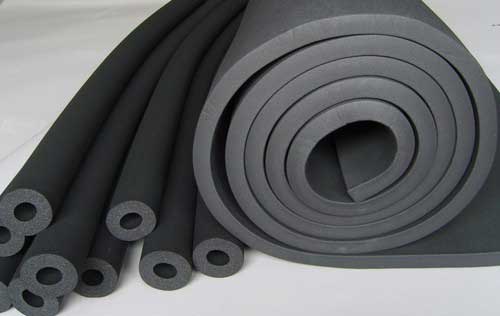 Elastomeric insulations
Elastomeric insulations| Grade | Basic description | Temp. Limits | Flame Spread Index / Smoke Developed Index |
| 1 | Widely used on typical commercial systems | -297°F to 220°F | 25/50 through 1.1/2in thickness. |
| 2 | High temp. uses | -297°F to 350°F | Not 25/50 Rated |
| 3 | Use on stainless steel applications above 125 °F | -297°F to 250°F | Not 25/50 Rated |
All three grades are flexible and resilient closed-cell expanded foam insulation. The maximum water vapor permeability is 0.10 perm-inch and the maximum thermal conductivity at 75°F temperature is 0.28 BTU in/(h ft2 F) for grades 1 and 3 and grade 2 is 0.30 BTU in/(h ft2 F). Grade 3 formulation does not contain any leachable chlorides, fluorides or polyvinyl chloride or any halogens.
The preformed tubular insulation is available in ID sizes from 3/8" to 6 IPS and in wall thickness from 3/8" to 1.1/2" and in typical length of 6 feet. The tubular product is available with and without pre-applied adhesive. The sheet insulation is available in continuous lengths of 4 feet widths or 3' x 4' and in wall thicknesses from 1/8" to 2". The sheet product is available with and without pre-applied adhesive.
These materials are normally installed without additional vapor retarders. Additional vapor-retarder protection may be necessary when installed on very-low-temperature piping or where exposed to continually high humidity conditions. All seams and termination points must be sealed with manufacturer recommended contact adhesive. For outdoor applications a weatherable jacket or manufacturer recommended coating must be applied to protect against UV and ozone.
Cellular Glass
Cellular Glass is defined by ASTM as insulation composed of glass processed to form a rigid foam having a predominantly closed-cell structure. Cellular glass is covered by ASTM C552, "Standard Specification for Cellular Glass Thermal Insulation" and is intended for use on surfaces operating at temperatures between -450 and 800°F. The Standard defines two grades and four types, as follows..
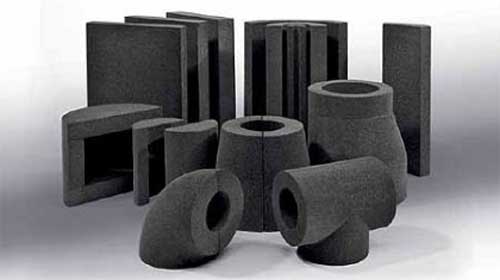 Cellular Glass insulations
Cellular Glass insulations| Type | Form and Grades Available |
| I | Flat Block, Grades 1 and 2 |
| II | Pipe and Tubing, Fabricated, Grades 1 and 2 |
| III | Special Fabricated Shapes, Grades 1 and 2 |
| IV | Board, Fabricated, Grade 2 |
Cellular glass is produced in block form (Type I). Blocks of Type I product are typically shipped to fabricators who produce fabricated shapes (Types II, III, and IV) that are supplied to distributors and/or insulation contractors.
The maximum thermal conductivity is specified, by grade, as follows (for selected temperatures)..
| Temperature,°F | Grade 1 | Grade 2 |
| Type I, Block | ||
| -150°F | 0.20 | 0.26 |
| -50°F | 0.24 | 0.29 |
| 50°F | 0.30 | 0.34 |
| 75°F | 0.31 | 0.35 |
| 100°F | 0.33 | 0.37 |
| 200°F | 0.40 | 0.44 |
| 400°F | 0.58 | 0.63 |
| Type II, Pipe | ||
| 100°F | 0.37 | 0.41 |
| 400°F | 0.69 | 0.69 |
The standard also contains requirements for density, compressive strength, flexural strength, water absorption, water-vapor permeability, combustibility, and surface burning characteristics.
Cellular glass insulation is a rigid inorganic non-combustible, impermeable, chemically resistant form of glass. It is available faced or un-faced (jacketed or un-jacketed). Because of the wide temperature range, different fabrication techniques are sometimes used at various operating temperature ranges.
Typically, fabrication of cellular glass insulation involves gluing multiple blocks together to form a "billet" which is then used to produce pipe insulation or special shapes. The glue or adhesives used vary with the intended end use and design operating temperatures. For below-ambient applications, hot melt adhesives such as ASTM D 312 Type III asphalt are usually used.
On above-ambient systems, or where organic adhesives could pose a problem (i.e., LOX service) an inorganic product such as gypsum cement is often used as fabricating adhesive. Other adhesives may be recommended for specific applications. When specifying cellular glass insulation, include system operating conditions to ensure proper fabrication.
Fibrous Insulations
Fibrous insulations are composed of small diameter fibers that finely divide the air space. The fibers may be organic or inorganic and they are normally (but not always) held together by a binder. Typical inorganic fibers include glass, rock wool, slag wool, and alumina silica.
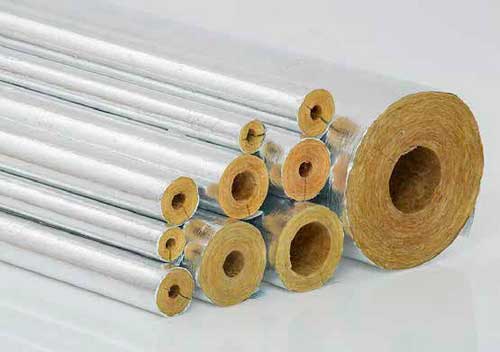 Fibrous Insulations
Fibrous InsulationsMineral Fiber Pipe
Mineral Fiber Pipe insulation is covered in ASTM C 547. The standard contains five types classified primarily by maximum use temperature.
| Type | Form | Maximum Use Temp,°F |
| I | Molded | 850°F |
| II | Molded | 1200°F |
| III | Precision V-groove | 1200°F |
| IV | Molded | 1000°F |
| V | Molded | 1400°F |
The standard further classifies products by grade. Grade A products may be "slapped-on" at the maximum use temperature indicated, while Grade B products are designed to be used with a heat-up schedule.
The specified maximum thermal conductivity for all types is 0.25 Btu in/(hr ft2 °F) at a mean temperature of 100°F.
The standard also contains requirements for sag resistance, linear shrinkage, water-vapor sorption, surface-burning characteristics, hot surface performance, and non-fibrous (shot) content. Further, there is an optional requirement in ASTM C 547 for stress corrosion performance if the product is to be used in contact with austenitic stainless steel piping.
Fiberglass pipe insulation products will generally fall into either Type I or Type IV. Mineral wool products will comply with the higher temperature requirements for Types II, III, and V.
These pipe insulation products may be specified with various factory-applied facings, or they may be jacketed in the field. Mineral fiber pipe insulations systems are also available with "self-drying" wicking material that wraps continuously around pipes, valves, and fittings. These products are intended to keep the insulation material dry for chilled water piping in high-humidity locations.
Mineral fiber pipe insulation sections are typically supplied in lengths of 36 inch, and are available for most standard pipe and tubing sizes. Available thicknesses range from 1/2in to 6in.
Granular Insulations
Calcium Silicate
Calcium Silicate thermal insulation is defined by ASTM as insulation composed principally of hydrous calcium silicate, and which usually contains reinforcing fibers.
Calcium Silicate Pipe and Block Insulation are covered in ASTM C 533. The standard contains three types classified primarily by maximum use temperature and density.
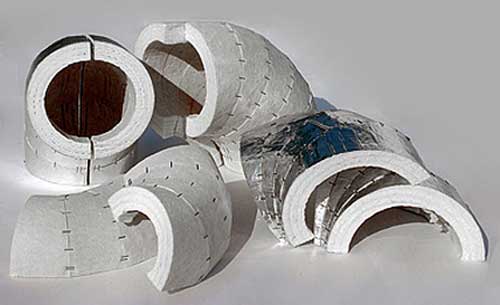 Calcium Silicate thermal insulation
Calcium Silicate thermal insulation| Type | Maximum Use Temp (°F) and Density |
| I | Max Temp 1200°F, Max Density 15 pcf |
| IA | Max Temp 1200°F, Max Density 22 pcf |
| II | Max Use Temp 1700°F |
The standard limits the operating temperature between 80°F to 1700°F.
Calcium Silicate pipe insulation is supplied as hollow cylinder shapes split in half lengthwise or as curved segments. Pipe insulation sections are typically supplied in lengths of 36 inch, and are available in sizes to fit most standard pipe sizes. Available thicknesses range from 1" to 3" in one layer. Thicker insulation is supplied as nested sections.
Calcium Silicate block insulation is supplied as flat sections in lengths of 36", widths of 6", 12", and 18" and thickness from 1" to 4". Grooved block is available for fitting block to large diameter curved surfaces.
Special shapes such as valve or fitting insulation can be fabricated from standard sections.
Calcium Silicate is normally finished with a metal or fabric jacket for appearance and weather protection.
The specified maximum thermal conductivity for Type 1 is 0.41 Btu-in/(h ft2 °F) at a mean temperature of 100°F. The specified maximum thermal conductivity for Types 1A and Type 2 is 0.50 Btu-in/(h ft2 °F) at a mean temperature of 100°F.
The standard also contains requirements for flexural (bending) strength, compressive strength, linear shrinkage, surface-burning characteristics, and maximum moisture content as shipped.
Typical applications include piping and equipment operating at temperatures above 250°F, tanks, vessels, heat exchangers, steam piping, valve and fitting insulation, boilers, vents and exhaust ducts.
Reference(s) ..
www.wbdg.org / www.roxul.com
More about Mechanical Insulation
Part 1: Types and Materials
Part 2: Space Requirements of Insulation
Part 3: Insulation of Piping